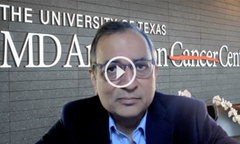
Phase 3 HIMALAYA Trial Shows OS Benefit of Durvalumab in HCC
Milind Javle, MD, discusses the phase 3 HIMALAYA study of durvalumab and tremelimumab in patients with locally advanced or metastatic hepatocellular cancer.
Milind Javle, MD, professor in the department of gastrointestinal medical oncology, division of cancer medicine at The University of Texas MD Anderson Cancer Center, discusses the phase 3 HIMALAYA study (NCT03298451) of durvalumab (Imfinzi) and tremelimumab (Imjudo) in patients with locally advanced or metastatic hepatocellular cancer (HCC).
The open-label, multicenter, global phase 3 HIMALAYA trial randomly assigned 1171 patients on a 1:1:1 basis to receive durvalumab plus tremelimumab (STRIDE), durvalumab alone, or sorafenib (Nexavar). The primary end point was overall survival (OS) improvement of STRIDE over sorafenib, and a secondary end point was noninferiority of OS of durvalumab versus sorafenib.
At a median follow-up of approximately 32 months, the median OS was 16.43 months for STRIDE, 16.56 months for durvalumab, and 13.77 months for sorafenib. The HR for superiority of STRIDE versus sorafenib was 0.78 [96.02% CI, 0.65-0.93; P = .0035] and the HR for noninferiority of durvalumab versus sorafenib was 0.86 [95.67% CI, 0.73-1.03; noninferiority margin, 1.08]. The objective response rate (ORR) was 20.1% for STRIDE, 17.0% for durvalumab, and 5.1% for sorafenib. According to Javle, the improvement in OS appeared to increase with time.
Javle says this trial was significant because it showed efficacy for an immune checkpoint inhibitor combination without VEGF-targeted agents, as patients with portal vein thrombosis or portal hypertension cannot receive the VEGF inhibitor bevacizumab (Avastin).
TRANSCRIPTION:
0:08 | The [HIMALAYA] study very remarkably achieved its aim with an improvement in OS demonstrable in the study arm, that is durvalumab and tremelimumab versus sorafenib. The survival improvement was around 13 months in the sorafenib arm as compared with 16 months in the STRIDE arm with a hazard ratio of 0.78. In the other 2 arms, that is the other arm durvalumab single-agent versus sorafenib, it was a noninferiority study design and that goal was achieved with the hazard ratio 0.86. Also interestingly, the response rate was higher with the STRIDE regimen over 20% versus 5% with sorafenib. The improvement in survival...appeared to increase with time. So, when you look at survival results at, say, 30 months, this difference was even greater.
So, I think this was a very important trial because it included a unique regimen of a combination of checkpoint inhibitors and did not include VEGF inhibitor–targeted therapy, because this is often a problem with systemic therapy for HCC as patients have portal vein thrombosis or portal hypertension and viruses and cannot get VEGF-directed therapies like bevacizumab. So [this is] certainly a very remarkable advance in HCC management. And I'm happy now that we have another tool in our toolbox for this cancer.











































